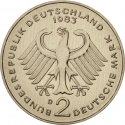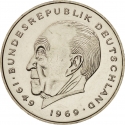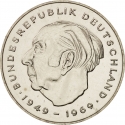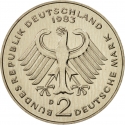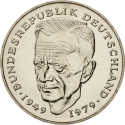You are about to finish your registration. Please check your mailbox (including spam folder). There should be a letter with a confirmation link. Check setting to make sure that your e-mail address is correct.
Send letter againDescription
The first Deutsche Mark coins were issued by the Bank deutscher Länder in 1948 and 1949. From 1950, the inscription Bundesrepublik Deutschland (Federal Republic of Germany) appeared on the coins.
Obverse

|
The coat of arms of Germany displays a black eagle with red feet, beak and tongue on a golden field. This is the Bundesadler or "Federal Eagle", formerly the Reichsadler or "Imperial Eagle". It is a re-introduction of the coat of arms of the Weimar Republic (in use 1919–1935) adopted by the Federal Republic of Germany in 1950. The current official design is due to Tobias Schwab (1887–1967) and was introduced in 1928. BUNDESREPUBLIK DEUTSCHLAND |
|---|---|
Reverse

|
Portrait of Ludwig Erhard. Dates 1948-1988 represent the 40th Anniversary of the Deutsche Mark. ·DEUTSCHE MARK· |
| Edge |
The "Deutschlandlied" (English: "Song of Germany") has been the national anthem of Germany since 1922. Since World War II and the fall of Nazi Germany, only the third stanza has been used as the national anthem. The stanza's beginning, "Einigkeit und Recht und Freiheit" ("Unity and Justice and Freedom") is considered the unofficial national motto of Germany, and is inscribed on modern German Army belt buckles and the rims of some German coins. EINIGKEIT UND RECHT UND FREIHEIT |
2 Deutsche Mark
Anniversary of the Federal Republic of Germany
40th Anniversary of the Deutsche Mark
Subscribe series
KM# 170 Jaeger# 445 Schön# 167
Anniversary of the Federal Republic of Germany
40th Anniversary of the Deutsche Mark
Characteristics
| Type | Commemorative Issue (Circulating) |
| Material | Cupronickel |
| Weight | 7 g |
| Diameter | 26.75 mm |
| Thickness | 1.79 mm |
| Shape |
|
| Alignment | Medal |
| Mints |
Bavarian Central Mint (D) Berlin State Mint (A) Hamburg Mint (J) Karlsruhe State Mint (G) Stuttgart State Mint (F)
|
Related coins
Anniversary of the Federal Republic of Germany
Anniversary of the Federal Republic of Germany
Anniversary of the Federal Republic of Germany


